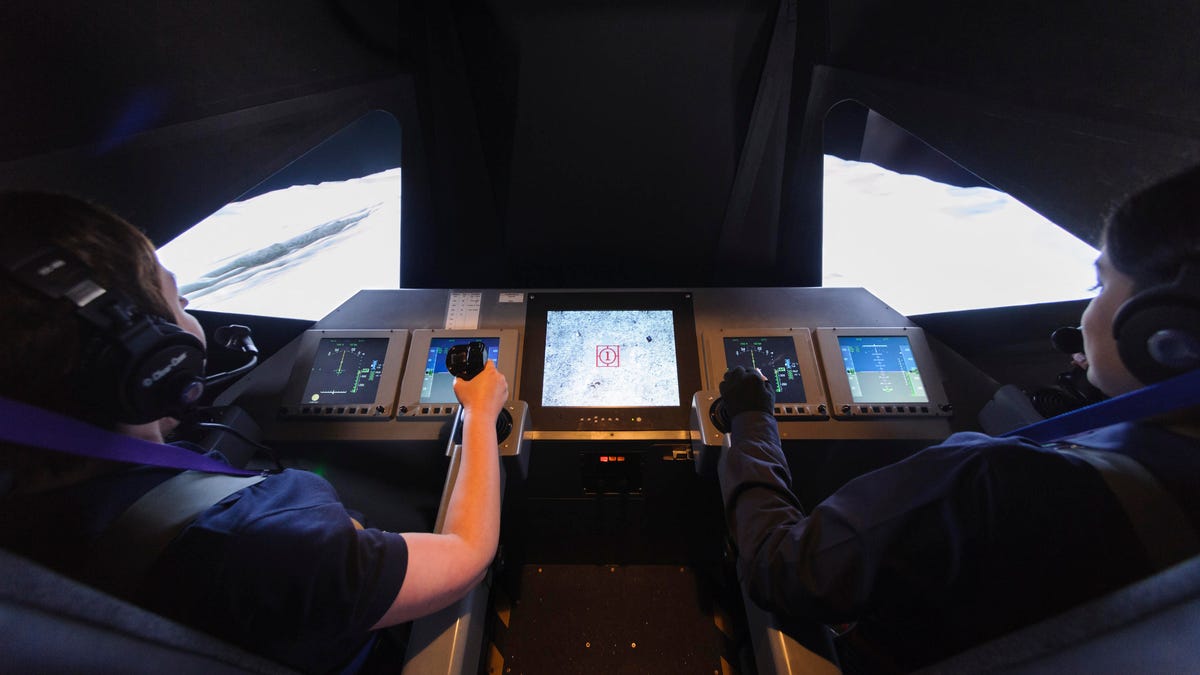Riding NASA’s moon landing simulator with chief Jim Bridenstine
The NASA administrator answers our questions about the Artemis program and the agency’s plans for putting the first woman on the moon.

Vertical Motion Simulator (VMS) Lunar Lander configuration with Bonnie Andro-Avila, left standing seat and Sumedha Garud in right standing seat "flying" the Lunar Lander simulation
As the 50th anniversary of the historic Apollo moon landing approaches, NASA is readying itself to return to the lunar surface.
The agency's best and brightest are hard at work to deliver on NASA's ambitious plans of getting back to the moon -- and establishing a permanent presence there -- by 2024. The new moon missions, named Artemis, will combine rockets, landers, rovers, and a new space station, the Lunar Gateway, in orbit around the moon to deliver robots, and eventually humans, back to the surface for the first time since 1972.
In May, we were invited to the NASA Ames Research Center at Moffett Field in California to participate in and film moon landing simulations with NASA Administrator Jim Bridenstine.
Bridenstine, an ex-Navy pilot who flew E-2 Hawkeye aircraft and F/A-18 Hornets, walked us through the landing procedures in NASA's state-of-the-art Vertical Motion Simulator (VMS) housed at NASA Ames.
You can see his expert piloting skills and hear the administrator's take on NASA's return to the moon in our interview below:
The VMS is the world's largest motion flight simulator and resides in a 10-story tower on the NASA Ames campus. It's powered by a massive hydraulic system that can simulate the movement of a real moon lander as it hits its target on the specified landing area on the moon. The simulator's cab has 6 degrees-freedom of motion in any direction, and as much as 60 feet of room vertically and 40 feet horizontally for simulating landings where the moon lander might be off course by some distance.
The exterior of the Lunar Lander "Explore Moon to Mars" cab
Our interview with Bridenstine was conducted in the VMS, with the NASA administrator playing captain to our simulated moon landing.
Boarding the simulator was very intimidating. First, we were outfitted with safety harnesses and then walked down a long, retractable walkway where we boarded the VMS. I could imagine what might be going through the astronauts' minds as they boarded their spacecraft. We were then strapped into the VMS by the NASA Ames staff in standing position at the control console. There was no seat so we were buckled into a padded vertical slab. As the simulation began, the motion was jolting, like a ride at Disneyland as the mission control computer moved us into position.
Everything went dark -- much like it would in space -- and we could communicate through pilot headsets inside the cabin. There was no way of telling how high up we were at the start of the simulation because all we could see out the windows was a computer graphics simulation of the moon's surface. As we came down we could feel the simulator jolting as the "boosters" corrected our position over the landing zone on our computer-generated moon.
When Bridenstine finally eased us to the surface and we "touched down" on the moon we felt a thud and then the simulator became eerily still. It was a thrilling experience -- one that mimicked what the astronauts in future missions will feel when they take their landers to the surface of the moon.
Bridenstine proved to be an ace pilot, making two successful landings on the virtual moon and explaining his long-term vision for NASA's Artemis missions at the same time. He explained how NASA chose the name Artemis -- which derives from the Greek goddess of the moon -- and shared his thoughts on the importance of putting not only the first man but also the first woman on the moon.
Administrator Jim Bridenstine pilots the Vertical Motion Simulator at NASA Ames Research Center in California.

